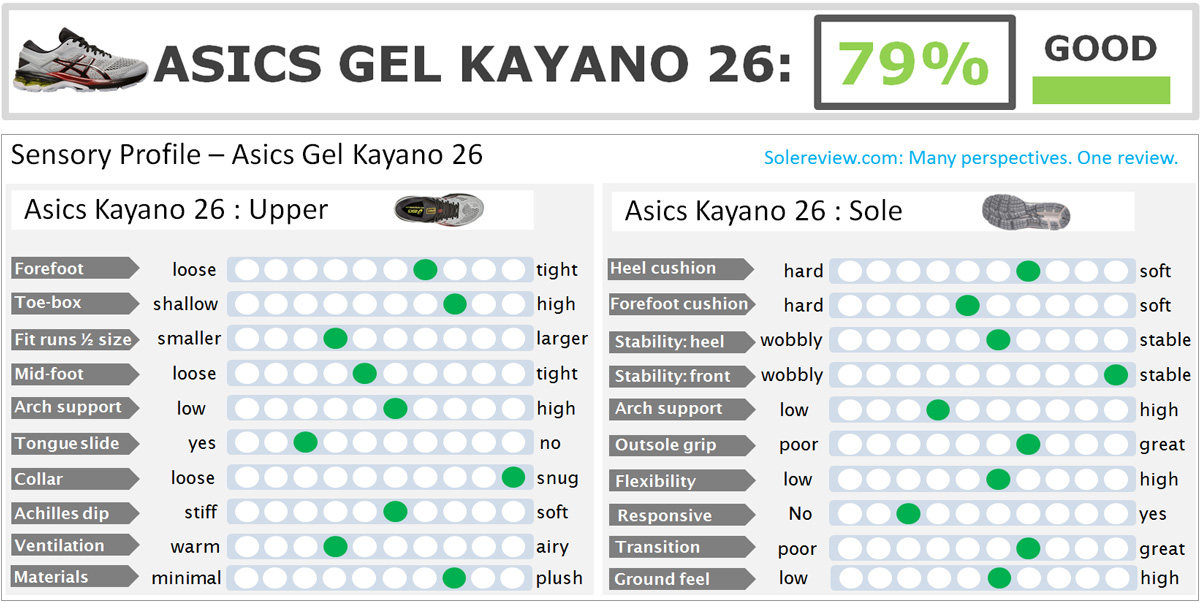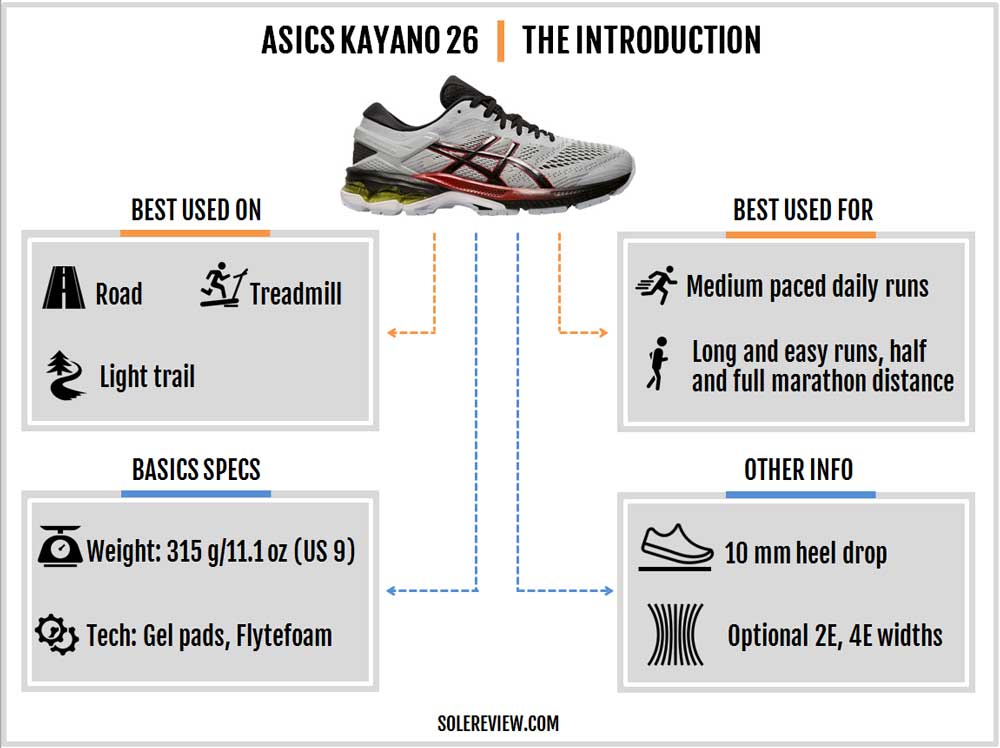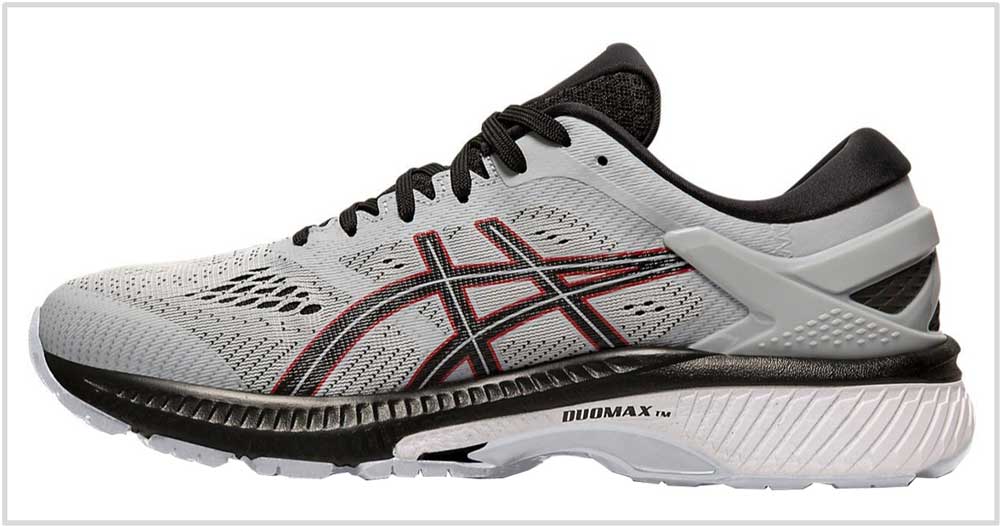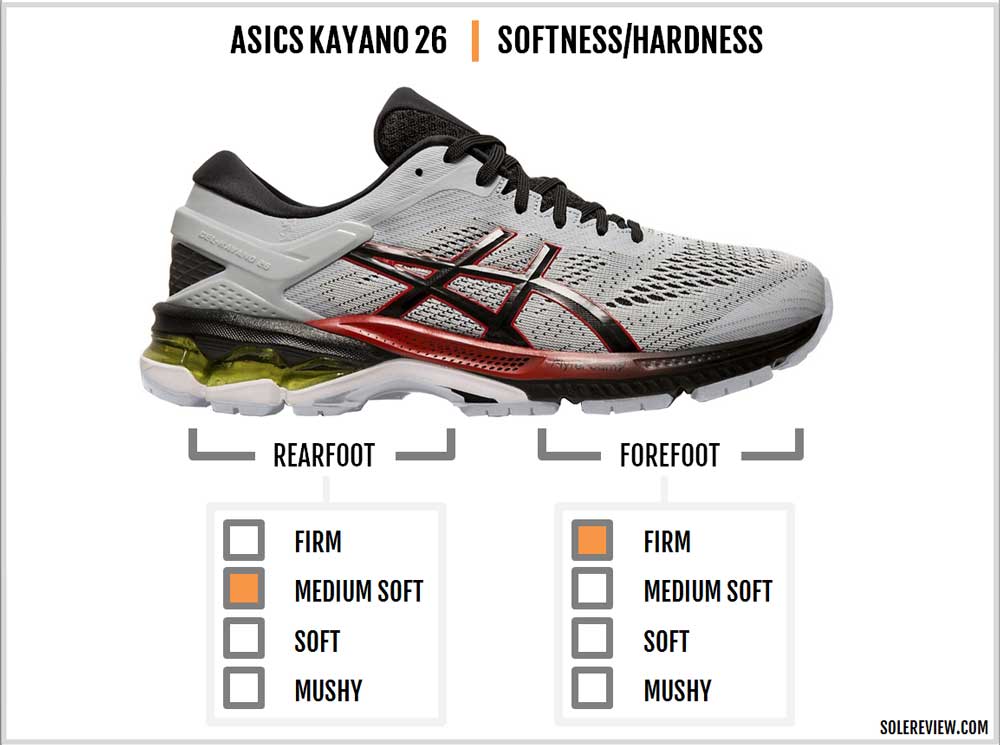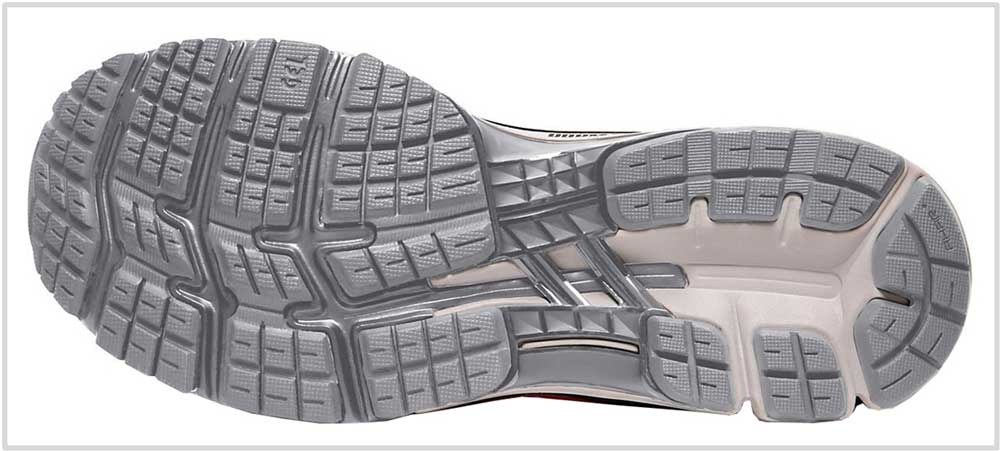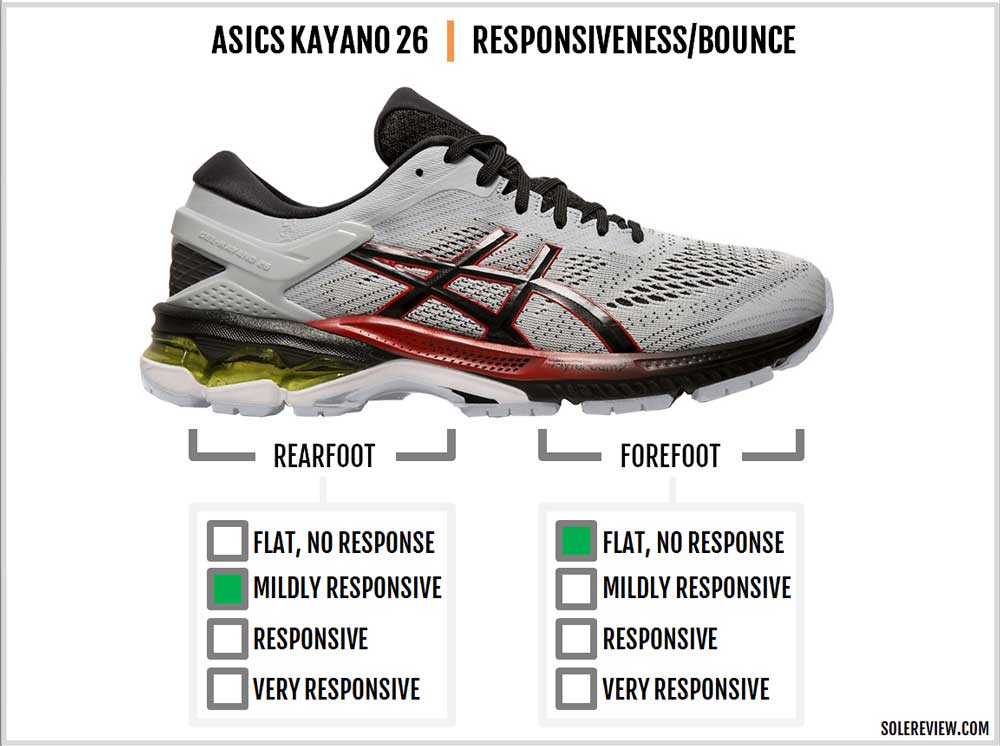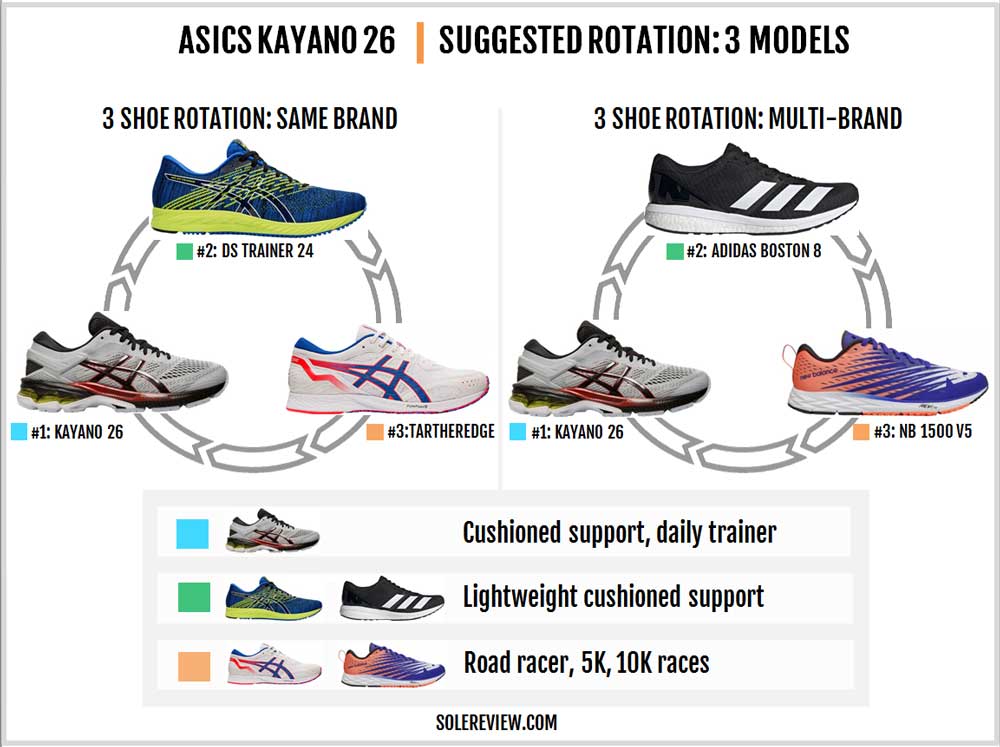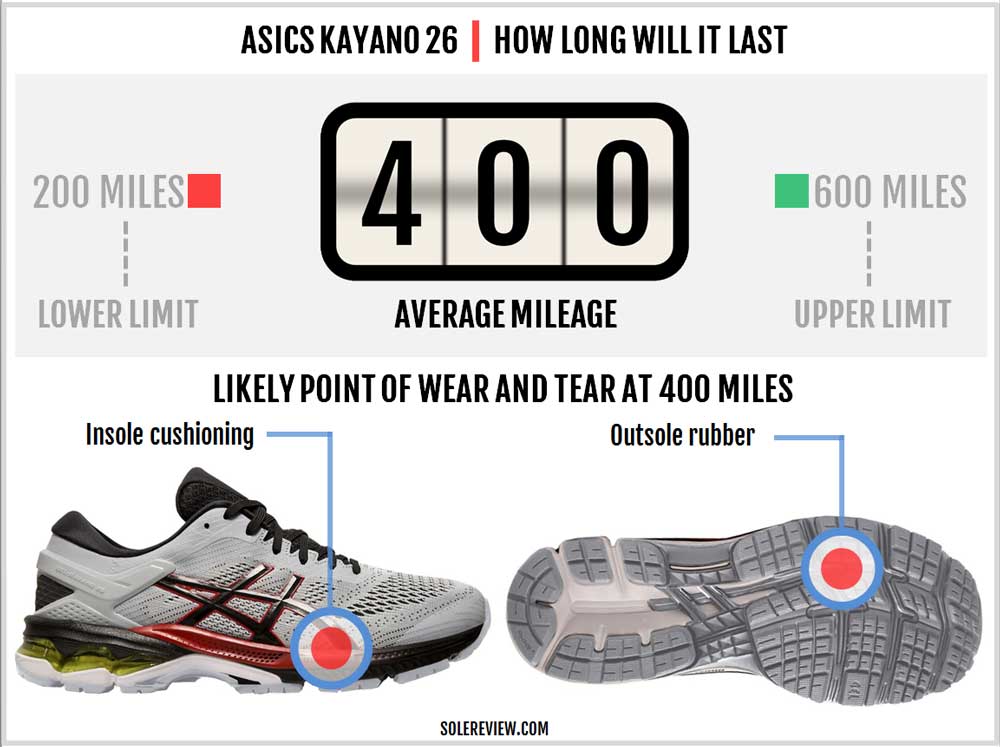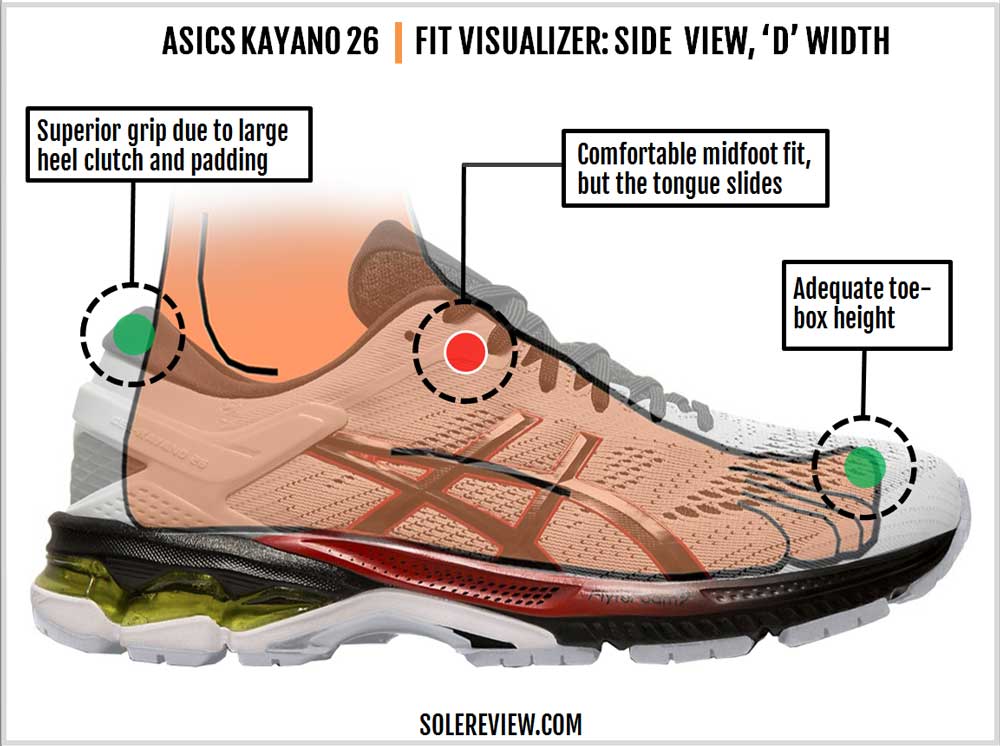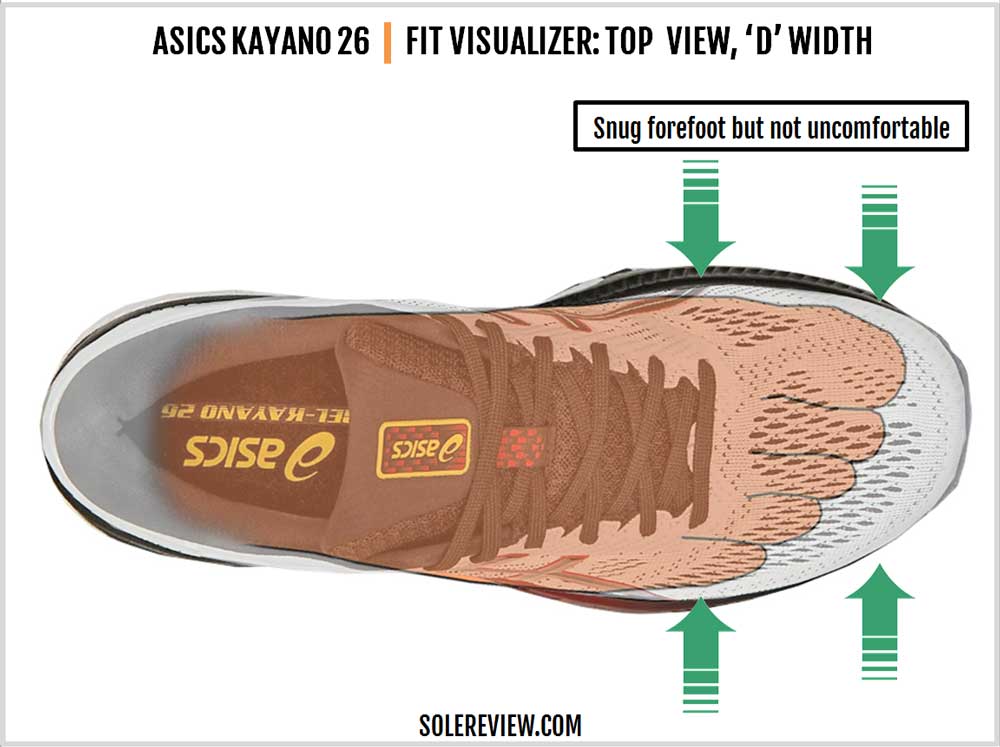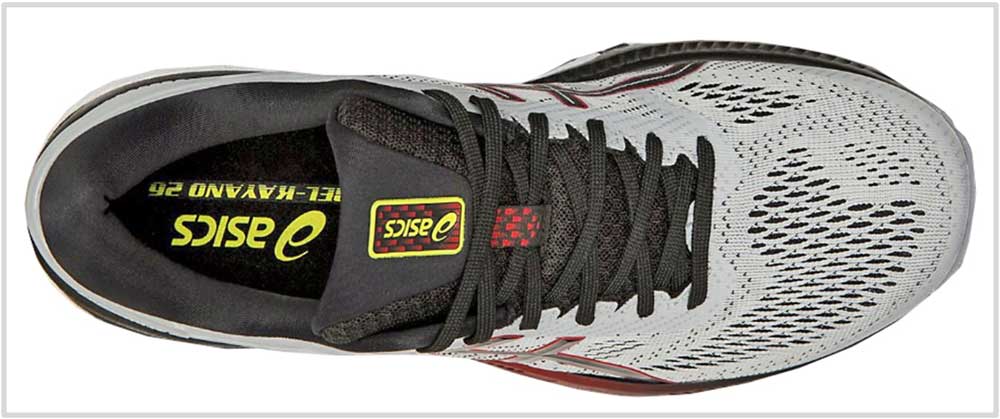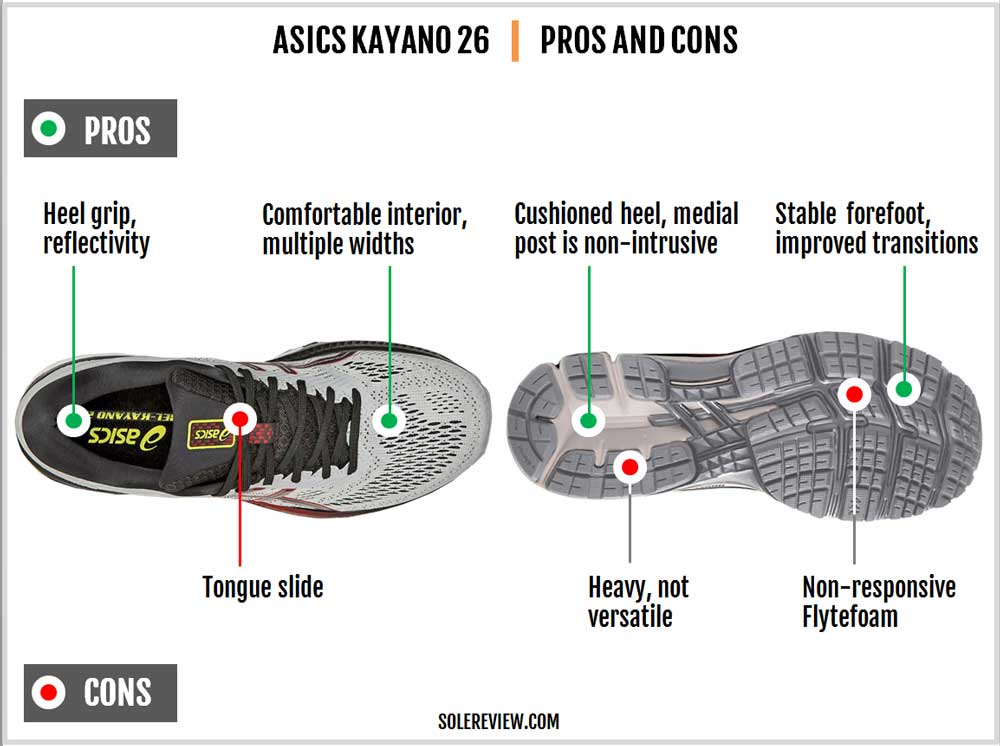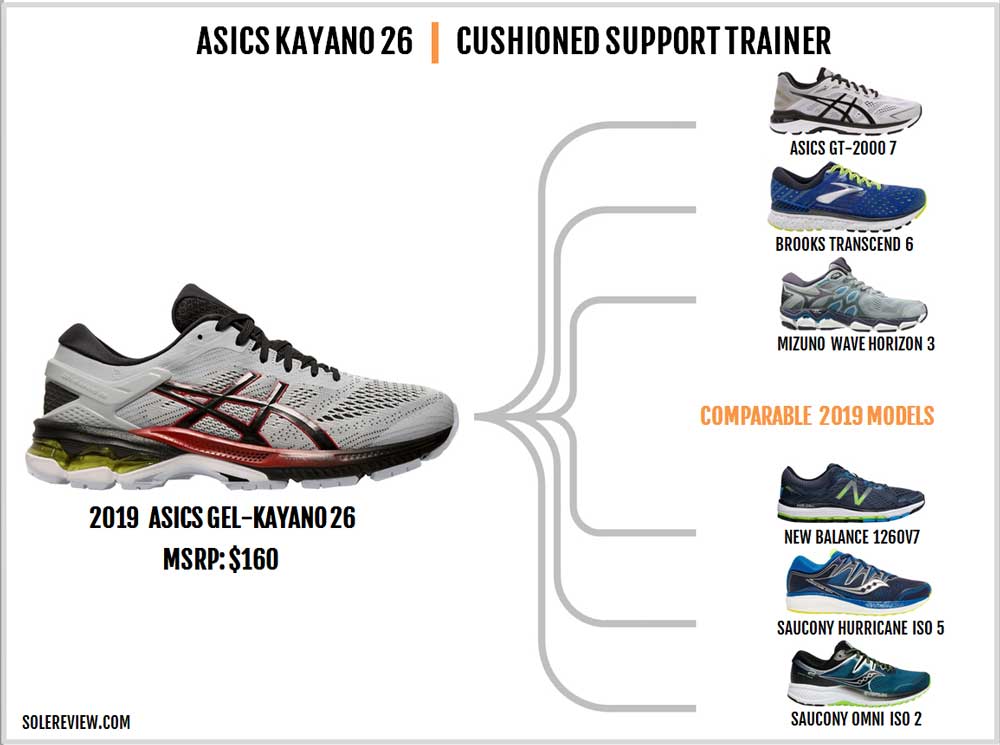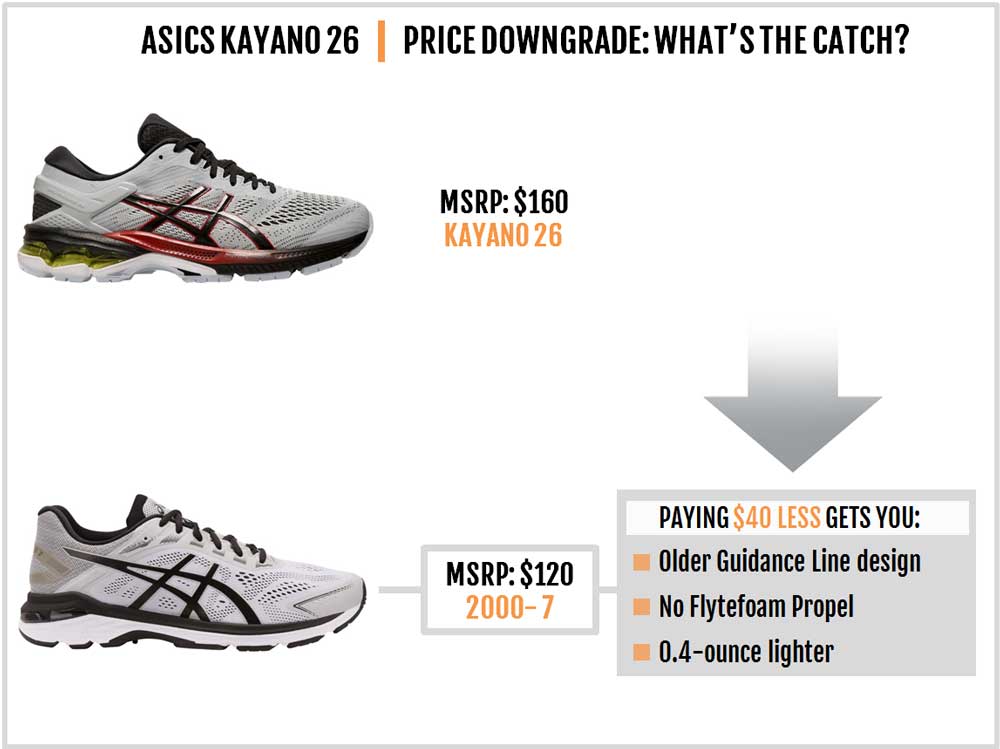When you make a purchase using the retailer links in our reviews, solereview may earn a small commission.
INTRODUCTION
It’s assuring to see the Kayano still going strong in a shoe category with a dwindling population of models. Running shoes with a medial-post used to form one of the hottest segments until a decade ago.
That is no longer true. With advancements in midsole foams, even neutral running shoes can be designed to make them inherently supportive. This diminishes the importance of medially-posted stability shoes, thus it’s no surprise that the brands are gradually showing these products the door.
Brooks, for example, has replaced its best-selling Adrenaline GTS with a namesake shoe which doesn’t have the medial post.
Sure, medially-posted running shoes are still widely available but they’re not as ubiquitous as they were 10 years ago.
The Kayano 26 is still a Kayano – at least in the sense you know it. A firmer ‘Duomax’ wedge is posted on the inner midsole, and visible Gel columns adorn the lateral midsole. This imbibes the ride character with a hint of motion control.
THE ASICS KAYANO 25 vs. 26
For the most part, the Kayano 26 is no more than a Kayano 25 with a few design tweaks.
Updates made to the sole makes the Kayano 26’s ride slightly smoother while decreasing the step-in softness. The upper is similar in overall design but has a snugger forefoot fit due to the new mesh and the heel clutching system.
THE RIDE EXPERIENCE
If you’re swapping your Kayano 25 for the 26, one of the first things you’ll notice upon wearing the new Kayano is the lower level of softness just under the foot.
That’s because Asics has replaced the blown-foam Ortholite insole with a smoother, compression-molded insole. It appears that Asics is making this change across the board because we’ve seen recent Asics shoes with this new insole.
As if to make up for the insole, the midsole becomes softer and smoother. The Flytefoam Propel which makes up the forefoot and top-layer above the medial-post is less stiff than the 25. The updated rearfoot with the larger visible Gel pads make the lateral side softer than last year.
The visible Gel pads are back; in an old-school way, we mean. Though the Kayano 25 had the touch-and-see Gel under the heel, it was small and recessed into the midsole.
The K-26 takes a leaf out of the Kayano 21’s design and brings back the segmented Gel pads in the rear.
Be like Nike; have Air, then show Air. If you have Gel, show Gel. Don’t be shy.
So that’s what Asics has done here. It makes the Kayano look more appealing while adding ride softness to the lateral heel.
Lest we forget, we must point out that the women’s Kayano 26 has a different midsole stack height than the men’s model. The men’s Kayano has a heel and forefoot stack of 22 and 12 mm to produce a 10 mm heel to toe drop. For the female version, a higher 13 mm drop and the softer ride is derived from a stacking ratio of 24:11 mm.
This is unique to Asics, a feature which the brand calls ‘gender-specific’ cushioning.
The forefoot doesn’t have the visi-Gel though; there’s a dime-sized unit inside the forefoot which has very little effect on the ride. The Kayano 24 was the last we saw of the forefoot Gel window and the dual-layered foam design. Thereafter, the forefoot became noticeably stiffer.
Though the forefoot still has a firm underfoot feel, the Kayano 26 reduces the forefoot stiffness in two ways. The layer of Flytefoam Propel is softer than the 25. The outsole has wider grooves which help the midsole flex better.
Outsole-wise, the Kayano is similar to the Nimbus 21 – in the sense that the ‘Guidance line’ is no longer the continuous channel which bisects the outsole.
It now stops short of the forefoot, so the lugs are no longer split into halves. The rubber strips now run as a single piece from side to side and are divided by large channel.
This redesign makes the forefoot transitions better. The older Guidance Line design made the forefoot landings and roll-overs somewhat lumpy; the new outsole remedies that. The blown rubber compound muffles the ride and provides a sufficient level of traction.
Responsive or bouncy the Kayano is not. Let’s rephrase that; the Flytefoam isn’t responsive. It has proved useful to decrease weight and increase durability over Asics’s traditional EVA foams, but that’s just about it.
One interesting change which the Kayano 26 makes to its midsole happens to be the raised sidewalls. To be honest, it looks inspired by the Brooks Guide Rails or the adidas ‘Propulsion rail’. While the Asics’s midsole isn’t as pronounced as the said examples, you can see the slight upwards taper on both sides.
With that, there’s a noticeable bump in the sensation of under-arch support. The new compression-molded insole with a contoured arch flare is a contributing factor as well. Midfoot stability is solid as always – the Kayano 26 has a full-sized Trusstic shank. The midsole and outsole unit has a healthy dose of traditionalism, a design choice which lands the Kayano in the 11-ounce weight class.
The firmer medial-post isn’t intrusive at all – and this isn’t new to the Kayano 26. The last time we saw an over-sized medial post was on the 2011 Kayano 17; versions after that padded the wedge with a softer layer of foam.
The 26 happens to be no different. So while you get a supportive medial side and a softer lateral side, you don’t feel the firmer portion pressing into your foot.
In that sense, the motion-control aspect of the Kayano is pretty similar to the K-25, 24, or the 23. There’s some compression bias favoring the outer midsole, but without making the shoe unstable.
Being a daily trainer is the best use-case for the Kayano 26. At over 11-ounces, this shoe weighs a lot more what we’re used to nowadays.
Thus, the Kayano isn’t very versatile. The Asics DS-Trainer 24 and the adidas Boston 8 work better for faster training runs. We know that the Boston isn’t a stability shoe per se, but the Tempo 9 has become a rare sight. You can, however, consider the Saucony Liberty ISO 2 for a touch for stability.
If you want to run a marathon, the Kayano isn’t a bad choice – there’s plenty of cushioning underfoot for long-distance comfort.
The Asics Tartheredge or the New Balance 1500V5 are excellent choices for short races and fast 5K, 10K runs. The New Balance 1500V6 is just out, so we’ll update this review as soon as we have weartest data.
IS THE KAYANO 26 DURABLE?
At a basic level, very little has changed in the Kayano’s construction. So you’ll get around 400 miles out of the Kayano, a number which has been the median (more like mode) lifespan of this model.
THE UPPER DESIGN AND FIT
The Kayano 26 fits a snugger in the forefoot and slightly shorter in size. And though the new engineered mesh has a closer-knit structure than the 25, that’s not the primary reason.
The plastic heel clutch of both the shoes look similar from the outside, but the K25’s clip had a bit of an outward curve. In comparison, the K-26’s heel has a straighter profile.
By now, you should know what happens next.
The foot is pushed slightly forward by a millimeter or so, but enough to affect the upper fit. The tighter structure of the upper mesh on the lower forefoot also contributes to the snugger feel.
This may be up for debate, but we still recommend that you buy the same size as the Kayano 25. The difference in the sizing isn’t a lot, so buying even a half size larger will upset the fit and ride dynamics. Get a 2E (wide) or 4E (extra wide) width if you have to.
The upper breathes well but isn’t as breezy as the Kayano 25. The latter had a liberal distribution of vents over the mid and forefoot. The medial midfoot did not have an Asics logo and relied on an internal layering for support. On the other hand, the 26 fuses a logo on the inner side and the mesh has a close-knit structure.
There’s no sleeve on the 26, so the tongue slides a bit during runs. So nothing has changed here; all Kayano editions so far had no gussets.
The padded tongue and heel use an ultra-soft lining with plenty of foam padding. The heel grips extremely well due to the rigid counter and quilted lining.
The tongue makes the interiors comfortable by taking the edge off the lacing. It helps that the new laces are flat and thinner instead of the traditional round kind seen on the K-25.
Reflectivity has always been a part of the Kayano, and you’ll find on the 26 too for dusk or dawn running.
We love the colors on the Kayano 26 this year – there are so many contemporary combos to choose from.
PROS AND CONS
$160 is a lot of cash for a running shoe, but at least the Kayano 26 looks the part.
Looks are subjective, but the visible Gel, a full-sized plastic shank, and plush upper materials and trims make the Kayano look and feel premium. And it’s not just the outside; the interiors feel smooth and comfortable over the foot.
The medial post isn’t noticeable. The Flytefoam top layer reduces the midsole bias and makes the rearfoot cushioned enough for longer runs. The shorter ‘Guidance Line’ improves the forefoot transition quality and flexibility while eliminating the lumpiness of the older Kayano’s.
But there are negatives. An 11-ounce build doesn’t cut it anymore, and nor does a foam material which lags behind its industry peers. And the Kayano should get an inner sleeve.
SHOES SIMILAR TO THE ASICS KAYANO 26
Besides the Asics GT-2000 7, there are three other models which are based on a similar stability shoe template. The New Balance 1260V7 has a large medial post blended into a cushioned, dual-density ride. The true-to-size upper uses premium materials to create a comfortable interior.
The Saucony Hurricane ISO 5 has a deeper cushioning due to its full-length Everun midsole. It has a large medial post, so you’ll get the familiar feel of a firmer inner midsole during runs.
Another Saucony shoe worth exploring is the Omni ISO 2. The medial-post isn’t intrusive, and the midsole offers a cushioned and slightly responsive ride. The transition groove splitting the outsole has shades of the Asics Kayano and the New Balance Vongo V4.
There are other non-traditional stability shoe options. The Mizuno Wave Horizon 3 has a plush yet supportive ride; the Brooks Transcend 6’s wide midsole and raised ‘Guide Rails’ deliver stability without having to use a medial post.
THE ASICS KAYANO 26 vs. GT-2000 7
You won’t get the ‘expensive’ look and feel of the Kayano when you purchase the GT-2000 7. However, if you find the K-shoe to be too bulky, the lighter 2000 is a good alternative. It has a small midsole post so its motion-control manners are toned down.
By the way, the GT-2000 8 will begin retailing on 10/1.
| Do you own this shoe? Improve this review by sharing your insights – submit a review here. |

